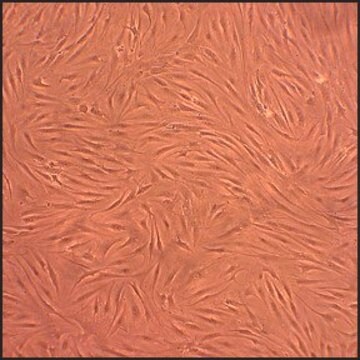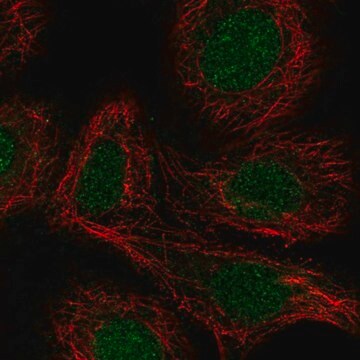LA-N-1
6041201, human nerve, Tear-drop shaped
Synonym(s):
LAN 1 Cells, LAN1 Cells
Sign Into View Organizational & Contract Pricing
All Photos(1)
About This Item
UNSPSC Code:
41106514
Recommended Products
product name
LA-N-1, 06041201
biological source
human nerve
growth mode
Semi-adherent aggregates
karyotype
Modal no. 87, range 47 - 87
morphology
Tear-drop shaped
products
Catecholamine
receptors
Not specified
technique(s)
cell culture | mammalian: suitable
relevant disease(s)
metastasis
shipped in
dry ice
storage temp.
−196°C
Cell Line Origin
Human Neuroblastoma Bone Marrow Metastasis
Cell Line Description
Established by Seeger et al., (1977) from neuroblastoma cells in the bone marrow of a 2-year-old male with clinical Stage IV neuroblastoma. The cells are neuroblastic, tear-drop shaped with multiple short fine cell processes (neurites). The cells are tumourigenic in nude mice. This is a catecholamine producing neuroblastoma cell line.LA-N-1 (Sigma Catalogue number 06041201), LA1-55n (Sigma Catalogue number 06041203) and LA1-5s (Sigma Catalogue number 06041204) have been shown to originate from the same patient by STR profiling.
Established by Seeger et al., (1977) from neuroblastoma cells in the bone marrow of a 2-year-old male with clinical Stage IV neuroblastoma. The cells are neuroblastic, tear-drop shaped with multiple short fine cell processes (neurites). The cells are tumourigenic in nude mice. This is a catecholamine producing neuroblastoma cell line.LA-N-1 (Sigma Catalogue number 06041201), LA1-55n (Sigma Catalogue number 06041203) and LA1-5s (Sigma Catalogue number 06041204) have been shown to originate from the same patient by STR profiling.
DNA Profile
STR-PCR Data: Amelogenin: X,Y
CSF1PO: 12
D13S317: 11,12
D16S539: 9
D5S818: 12
D7S820: 10,11
THO1: 8,9.3
TPOX: 8,11
vWA: 16,19
CSF1PO: 12
D13S317: 11,12
D16S539: 9
D5S818: 12
D7S820: 10,11
THO1: 8,9.3
TPOX: 8,11
vWA: 16,19
Culture Medium
EMEM (with non-essential amino acids) and Ham′s F12 (1:1 mixture) + 2mM Glutamine + 10% Foetal Bovine Serum (FBS)
Subculture Routine
For routine maintenance, split cultures only after they have become very dense i.e. split once every 2-3 weeks at a 1:20 - 1:100 ratio; 8% CO2; 37°C. Cells grow best and are most adherent on a plastic substrate in medium at a pH of 6.9 - 7.2; they do not tolerate more alkaline pH well. Population doubling time is approximately 2 days; saturation density is >1,000,000 cells/cm2. Cells grow in weakly adherent clusters. Allow all floating clumps to settle and withdraw most of the medium. Remove attached cells from substrate with 0.1% trypsin or PBS alone, cells will detach in <5 minutes. Remaining cells, if any, are large, flat and tightly adherent precursors of Schwann cell/glia/melanocyte lineages. If desired they should be removed from the substrate with trypsin/EDTA. When the neuronal cells are seeded into a new flask the cells attach slowly and may remain in suspension for one to several days; do not change the medium the day after passage. Floating clumps of cells are viable. This passage schedule will select for cells retaining a neuroblastic phenotype; cultures transferred more frequently, with larger inocula, and/or with trypsin/EDTA may gradually lose their neuroblastic properties due to overgrowth by spontaneously arising, non-neuronal adherent cell variants. When cells are resuscitated from a frozen ampoule the cells may appear dead after a day, but reattach and resume growth within 2-3 days reaching confluence by 7 days.
Other Notes
Additional freight & handling charges may be applicable for Asia-Pacific shipments. Please check with your local Customer Service representative for more information.
Certificates of Analysis (COA)
Search for Certificates of Analysis (COA) by entering the products Lot/Batch Number. Lot and Batch Numbers can be found on a product’s label following the words ‘Lot’ or ‘Batch’.
Already Own This Product?
Find documentation for the products that you have recently purchased in the Document Library.
Our team of scientists has experience in all areas of research including Life Science, Material Science, Chemical Synthesis, Chromatography, Analytical and many others.
Contact Technical Service


